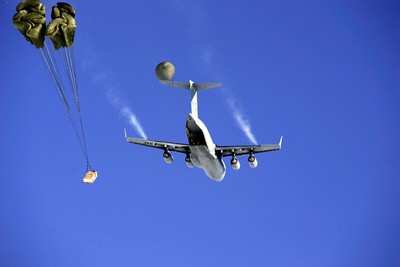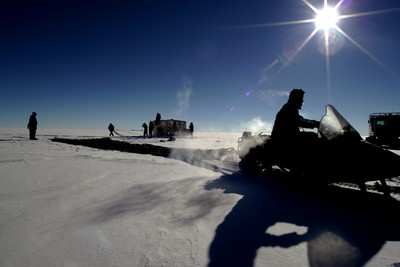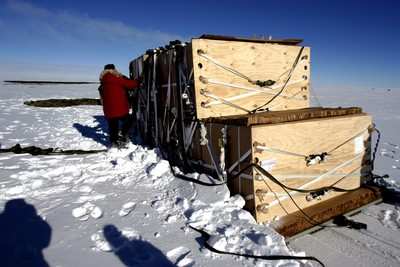70,000 Lbs. Of Supplies Delivered
Aero-News has learned an impressive airpower milestone was
reached December 20, with the completion of the first C-17
Globemaster III airdrop mission that delivered about 70,000 pounds
of supplies to the South Pole.

The airdrop's success is due to the combined effort of people
from Joint Task Force-Support Forces Antarctica Operation Deep
Freeze; the 62nd Airlift Wing; the 446th Airlift Wing; the 82nd
Airborne Division; the Royal New Zealand Defense Force; the
National Science Foundation; and Raytheon Polar Services
Corporation.
By validating the C-17 capability of conducting an airdrop at
the geographical South Pole, JTF-SFA's Operation Deep Freeze
demonstrated its ability to provide mid-winter emergency re-supply
and flexible support to the National Science Foundation and U.S.
Antarctica Program. Operation Deep Freeze is a unique joint and
total force mission that first anchored U.S. national policy in
Antarctica in 1955.
The ability to airdrop supplies using the C-17 -- versus the
ski-equipped LC-130 Hercules, the traditional aircraft used to
airland supplies on the ice -- allows aircrews to deliver up to
four times as much supplies in a single airdrop mission in
conditions that do not allow airland missions.

During the winter season at the South Pole, temperatures often
dip as low as minus 100 degrees Fahrenheit. That can paralyze an
aircraft's hydraulic systems, crystallize the fuel and solidify
lubricants. Around-the-clock darkness and crosswinds up to 60 miles
per hour create blizzard conditions and zero visibility, making it
impossible for an aircraft to land.
A medical emergency in 1999 highlighted the need to maintain a
mid-winter airdrop resupply capability to sites in Antarctica. In
that year, Dr. Jeri Nielsen, the only physician at Amundsen-Scott
South Pole Station, critically needed medical supplies to treat her
tele-medically diagnosed cancer. An LC-130 airland mission was not
possible before October, so NSF requested and funded an Air
Mobility Command out-of-cycle airdrop of medical supplies to the
South Pole station.
A C-141, with a handpicked aircrew from the 62nd AW and 446th AW
from Washington's McChord Air Force Base, was called to execute the
aerial delivery. The nearly 50-flying-hour mission was described by
then-AMC commander Gen. Charles T. Robertson Jr., as "a truly
heroic effort."

The 2006-2007 Operation Deep Freeze kicked off in August with
C-17 flights from Christchurch, New Zealand to McMurdo Station to
stage essential personnel and equipment to prepare the ice runway
for the main C-17 and LC-130 operations. Main body resupply
consists of C-17 intercontinental flights between ChristChurch and
McMurdo Station and LC-130 flights from McMurdo to South Pole and
other camps throughout Antarctica.
Up to two C-17s based at Christchurch fly missions as required
each week while up to nine LC-130s, depending on mission
requirements, fly multiple daily missions daily from their hub at
McMurdo Station.
Vessel re-supply operations consist of two Military Sealift
Command vessels delivering fuel and supplies to McMurdo Station. In
early January, prior to the MSC vessels' arrival, the US Coast
Guard icebreaker Polar Sea will cut a channel through miles of ice
allowing the ships access to the McMurdo Ice Pier.

The US Navy ran the first Operation Deep Freeze mission in 1955
for exploration and scientific research and began supporting the
National Science Foundation's research in Antarctica in 1959. The
operation has evolved into a huge logistical effort, moving
passengers and cargo for the NSF's research facilities in
Antarctica.
(Aero-News thanks Armed Forces Print News for its
report)
 Aero-News: Quote of the Day (04.17.24)
Aero-News: Quote of the Day (04.17.24) ANN's Daily Aero-Linx (04.17.24)
ANN's Daily Aero-Linx (04.17.24) Airborne-Flight Training 04.17.24: Feds Need Controllers, Spirit Delay, Redbird
Airborne-Flight Training 04.17.24: Feds Need Controllers, Spirit Delay, Redbird Airborne 04.16.24: RV Update, Affordable Flying Expo, Diamond Lil
Airborne 04.16.24: RV Update, Affordable Flying Expo, Diamond Lil Airborne 04.11.24: SnF24!, King's 50th, Top Rudder, Aileronics
Airborne 04.11.24: SnF24!, King's 50th, Top Rudder, Aileronics






